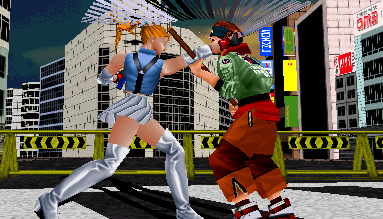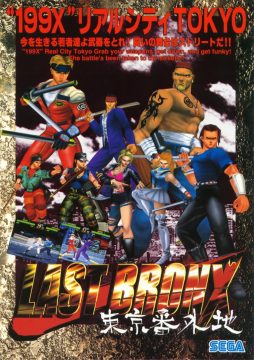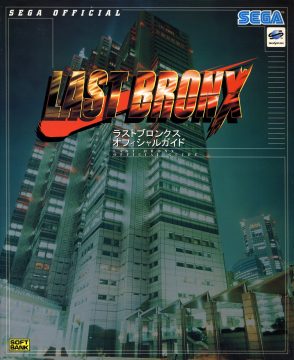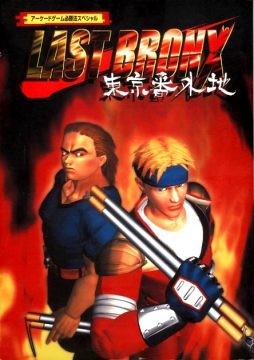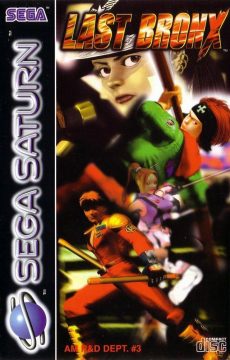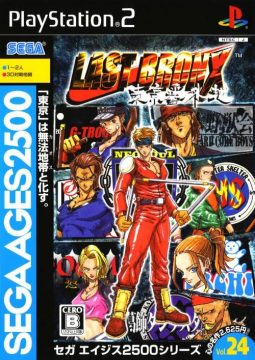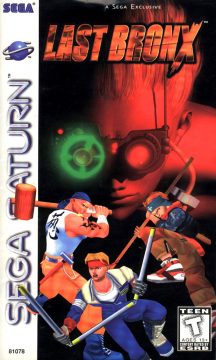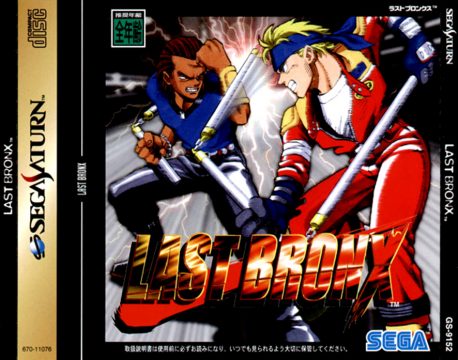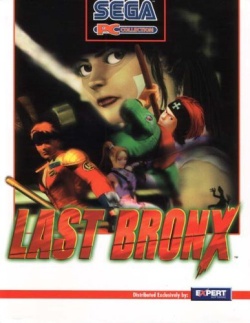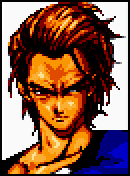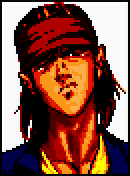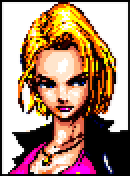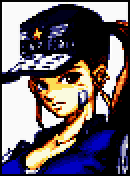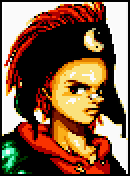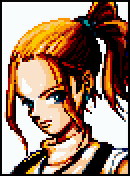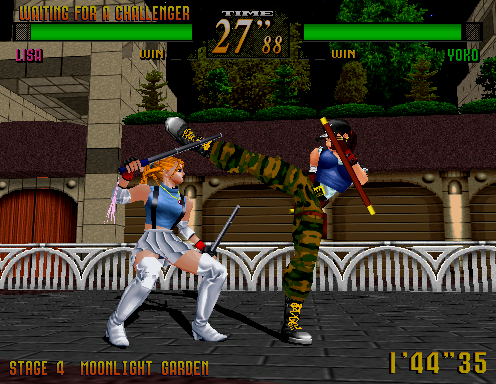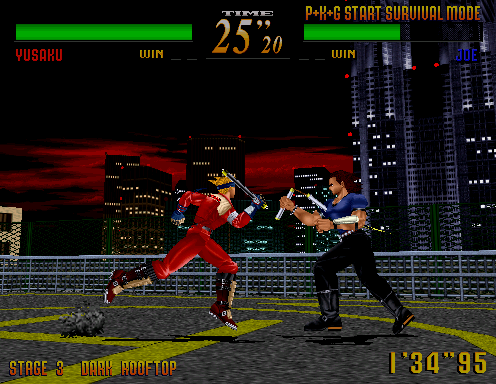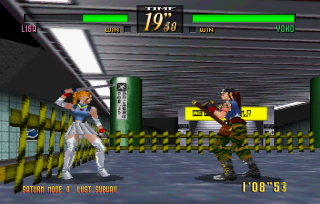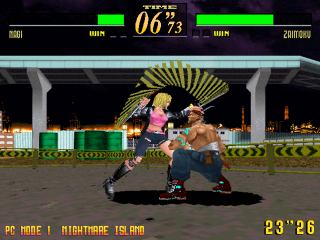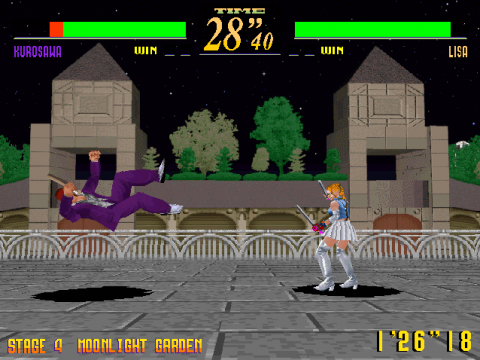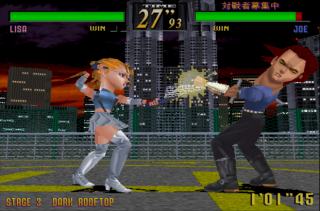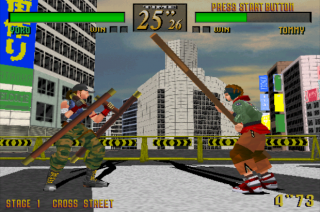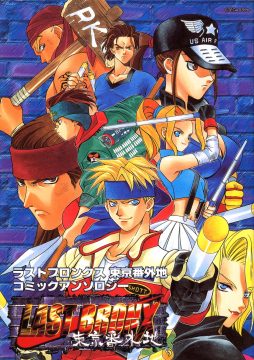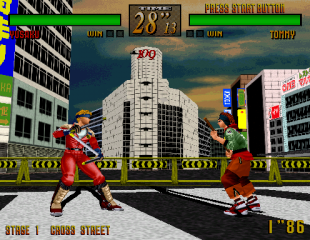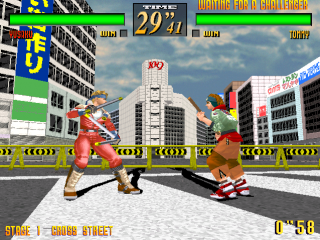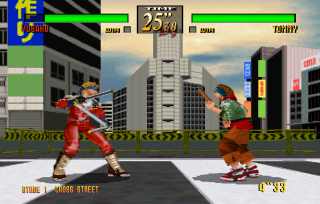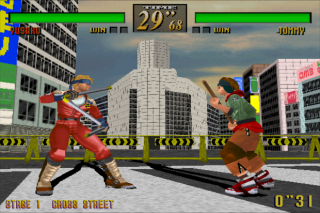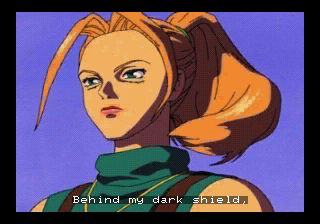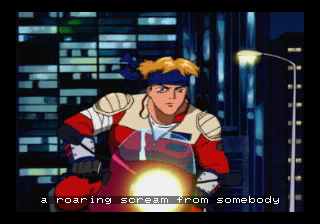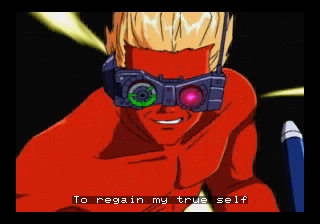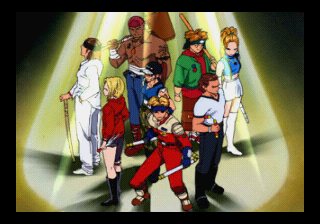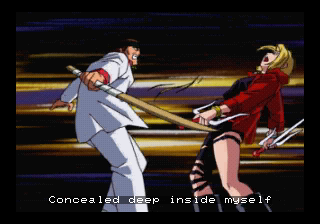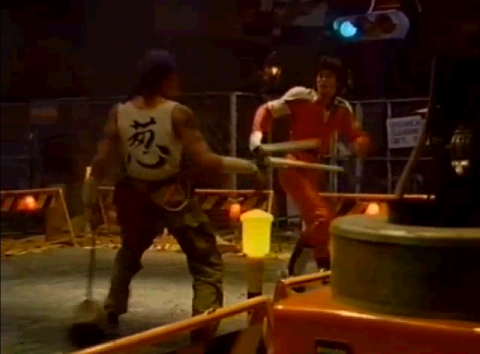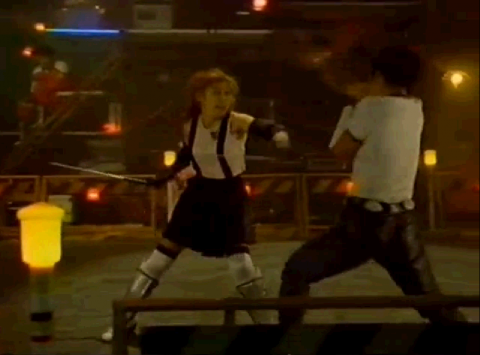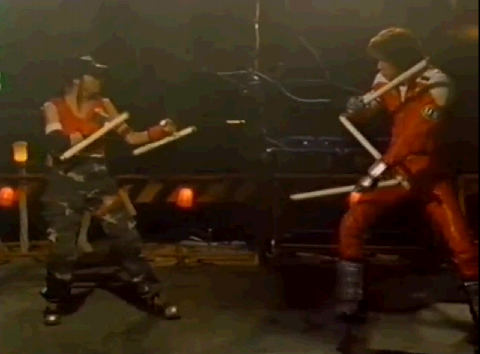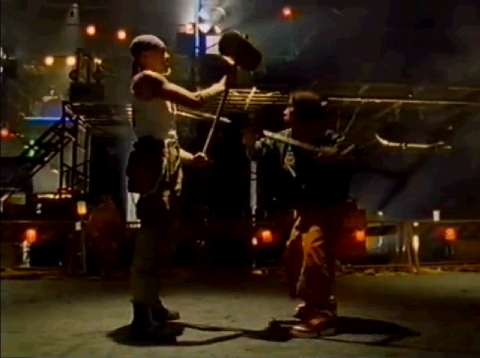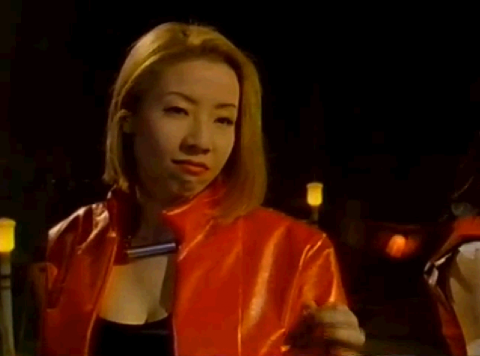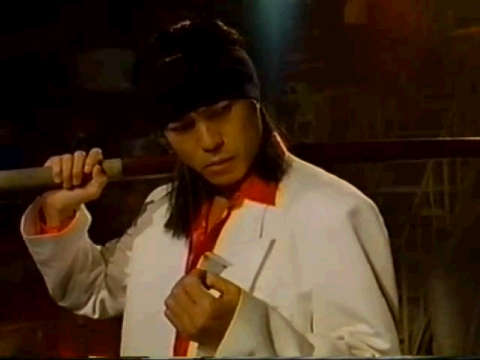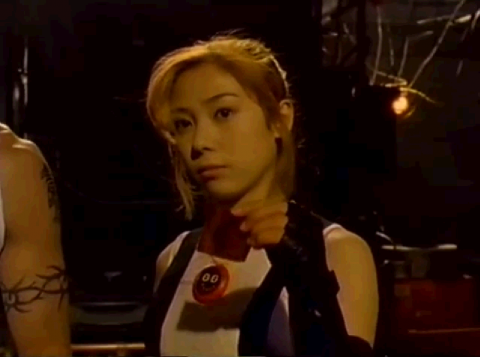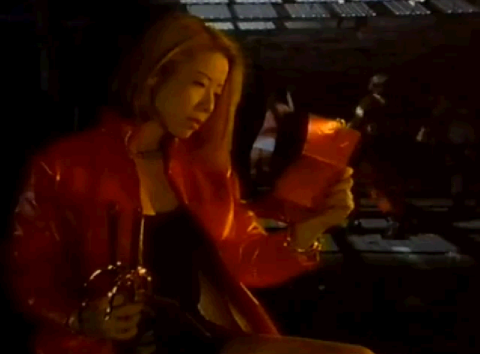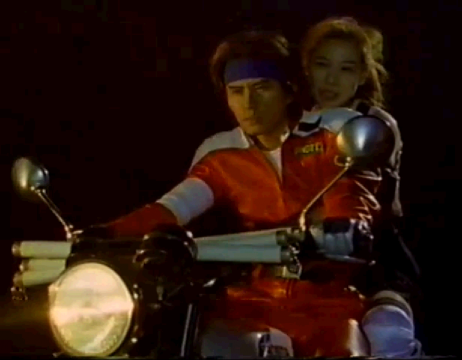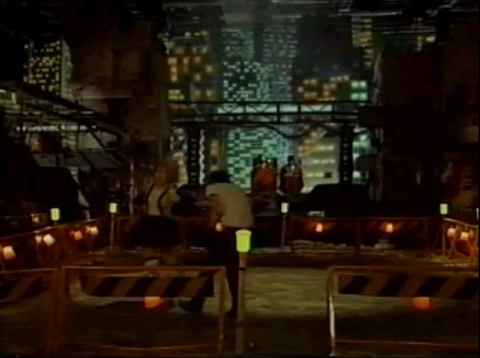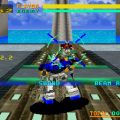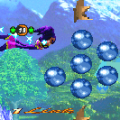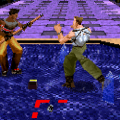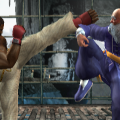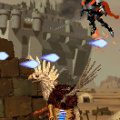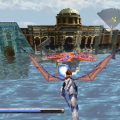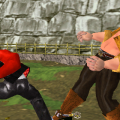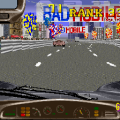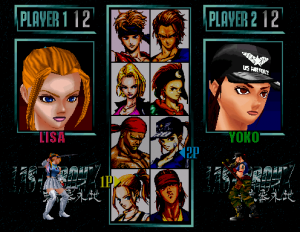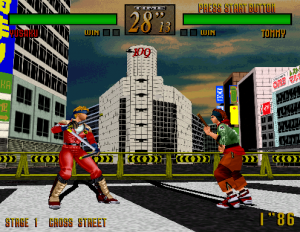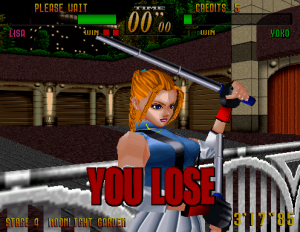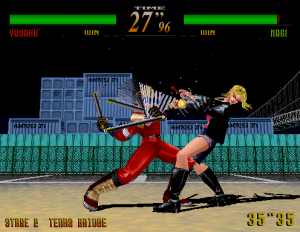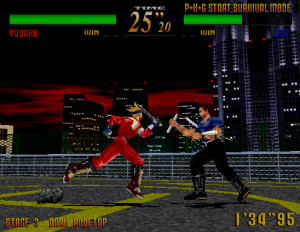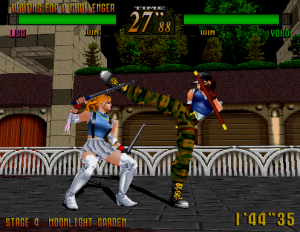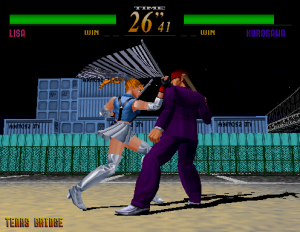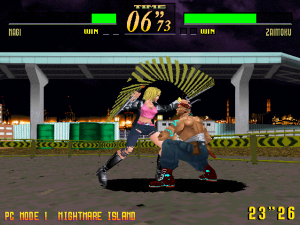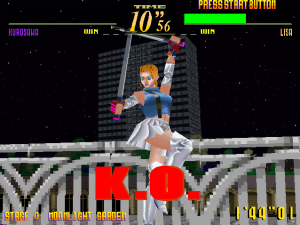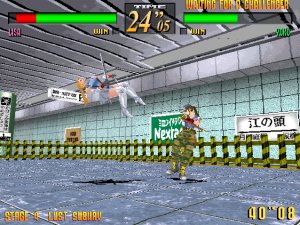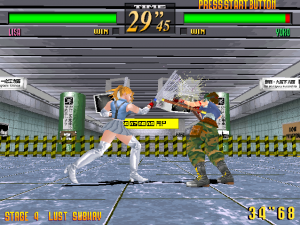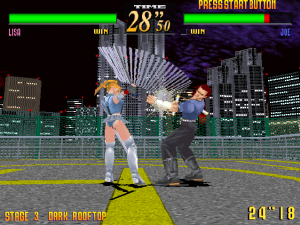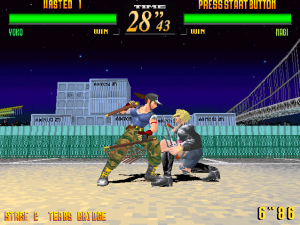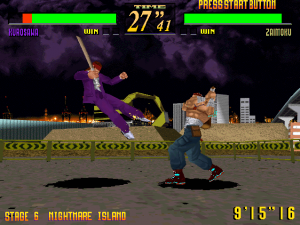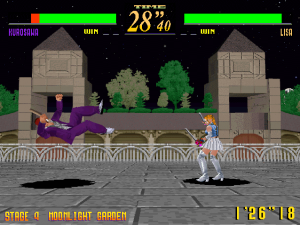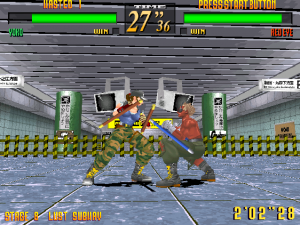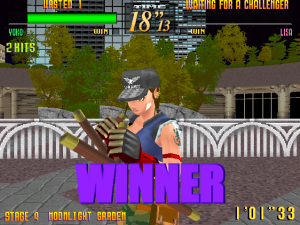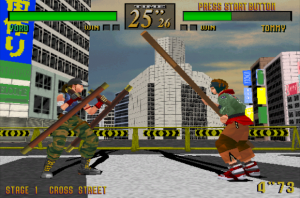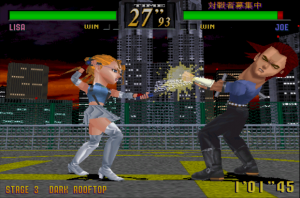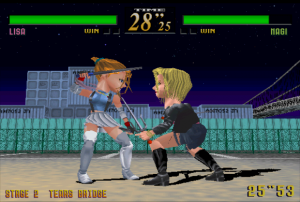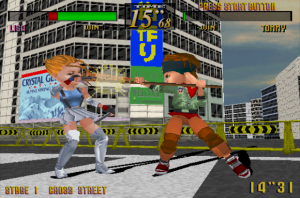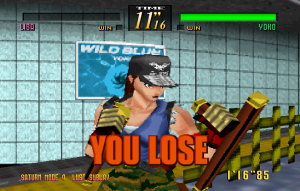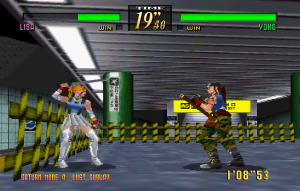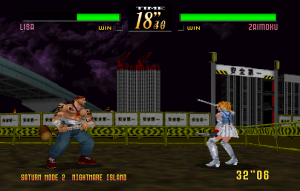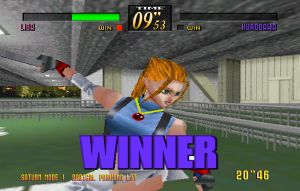Last Bronx‘s 1996 arcade release coincided with the high-water mark of Virtua Fighter 2‘s Japanese popularity. Sega were enjoying a topsy-turvy period whereby their traditional strongholds in America and Europe had evaporated and been replaced by domestic popularity. The one factor that had not changed was Sega’s arcade dominance, driving the Saturn’s unexpected Japanese success. With the original Virtua Fighter home conversion enjoying huge popularity with the Saturn’s launch, it was clear that Sega’s arcade games were equally vital to the home market and the company’s increasingly fragile bottom line.
In this context, it is unsurprising that Sega would try to wring every last drop of creative and fiscal juice from its Virtua Fighter model. The interleaving of Fighting Vipers characters into the Saturn exclusive Fighters Megamix makes this connexion explicit. Last Bronx can be seen as trying to ride the 3D zeitgeist that Yu Suzuki’s AM2 defined. However, for all its adoption of Virtua Fighter‘s mores, Last Bronx had a distinctive appeal that formed part of a three pronged assault on the nascent 3D fighting genre. Virtua Fighter was designed to be a highly technical game, light on humour, heavy in depth. Fighting Vipers was a breathless, off-beat title with esoteric character design and an overblown play-style. Last Bronx was the weapons based, narratively driven title with mechanics as taut and gritty as its alternative Tokyo setting. Indeed, such realism lent itself to trans-media promotion, with the standard manga tie-in being supplemented by radio plays and short films made viable by the closeness of the setting to the real world.
However, it was not just the setting or the weapon-based game mechanics that differentiated Last Bronx from its stablemates. As one of the first motion-captured 3D games, the other being Soul Edge/Blade, Last Bronx‘s characters moved with a vicious fluidity that added a further layer of realism to the underground setting. Indeed, the motion capture was so core to Last Bronx‘s feel that a movie detailing the process was released in Japan. The distinctive motion-blur on the weapons accentuated the cruelty and created a title that, for all its realism, was visually highly distinctive. The pounding, techno-infused music, produced by Tomoyuki Kawamura whose previous work included Virtua Racing‘s spartan soundtrack, dovetailed with these aesthetics and gameplay to create a believable congruent world whose stories felt real in a way unmatched by contemporary titles.
Whilst AM2 developed both Virtua Fighter and Fighting Vipers, Last Bronx fell to AM3 with Hisao Oguchi as executive producer, supported by Seiichi Yamagata and Masaki Takahashi as designers. Last Bronx was a departure for AM3, whose only previous combat game experience came from the unorthodox mech-based fighter Virtual On. Whilst AM3 continued their work in other genres, notably sports (Decathlete, Winter Heat, Virtua Tennis) and driving games (Crazy Taxi, Jambo Safari and the home conversions of Sega Rally, Daytona USA Circuit Championship Edition and Manx TT), Last Bronx represents an evolutionary dead end with neither a direct sequel nor any similar titles developed by the team.
The Japanese version of Last Bronx is subtitled Tokyo Bangaichi, which can be translated something vaguely like “Tokyo Wasteland”.
Released on Sega and Lockheed Martin’s Model 2B arcade board (1996) and brought home to the Saturn (1997), PC (1998) and PlayStation 2 (2006), Last Bronx is set in an alternative near-future Tokyo where rival gangs vie for control of the city. This dystopian, post-bubble re-imagining of the world’s largest metropolis, developed in the midst of Lost Decade anxiety, created a believable world with violent gameplay taking place across many of Tokyo’s iconic landmarks. Character design, lead by Yoshitsugu Sato who later patronized the fantastical in Final Fantasy IX and Crazy Taxi, eschews Fighting Vipers’ left field esoterica and Virtua Fighter‘s martial verity, concentrating instead on Harajuku inspired gang culture. The result is distinct, identifiable characters that feel believable without recourse to stereotypes or gimmicks.
Whilst 2D fighters of the era sported large character rosters, Street Fighter Zero/Alpha 2 had 18 whilst King of Fighters ’96 had 27, 3D titles were more restrained. The genre defining Virtua Fighter‘s concentration on technical depth led to the comparatively limited selection, creating a model whereby each fighter represented a dramatically different style of martial art. In early 3D fighters there was no Ken/Ryu style palette swapping that features in the Street Fighter series, and thus a far smaller, but highly individualised, selection was the norm. Last Bronx‘s eight strong character roster was broadly standard for the time, matching the original Virtua Fighter and Soul Edge/Blade, though lagging behind Virtua Fighter 2 and Tekken 2 as these titles touched double figures for protagonists. Last Bronx‘s emphasis on interlocking story lines between the characters also limited numbers. A balance was struck between variety and narrative, resulting in a background that engages without sprawling, placing meaningful gameplay centre stage.
The central story of the arcade version follows the events of a fighting tournament staged by the Redrum organization to end a power vacuum in the Tokyo underworld. Since the all-powerful Soul Crew street gang disintegrated, Tokyo has been lawless as rival gangs vie for control of the city. Whilst all the characters have their own reasons for being involved, Yoko Kono occupies a central role in the narrative as she attempts to find her missing brother. Yoko’s journey culminates in a battle with Red Eye, a servant of Redrum, who reveals that he is her brother. He was brutally beaten and burnt in a fire, becoming deranged and cruel with an anger eventually harnessed by Redrum. Whilst each character’s journey is individual, they are all involved in the same Redrum organized tournament, and thus all end with a boss battle against Red Eye.
Characters
Yusaku Kudo
As the name of his gang, Neo Soul, implies, Yusaku’s group are the spiritual successor’s to Soul Crew. Formerly third in command of Soul Crew, Yusaku’s rivalry with Kurosawa marks him out as the central protagonist in Last Bronx‘s Saturn/PC modes. He fights with a sansetukon, a three-sectioned staff, and his alternative weapon is a model of the Shinkansen.
Stage: ‘Naked Airport’ (Haneda Airport).
Music: ‘Disco Baby’.
Joe Inagaki
With the death of Soul Crew’s leader, Joe, who was second in command, decided to form his own gang. Taking like-minded bikers from his former gang, he formed Shinjuku Mad. The nunchuku is used in combination with traditional fist fighting by Inagaki, whilst his alternative weapons are ears of corn.
Stage: ‘Dark Rooftop’ (Shinjuku).
Music: ‘Bass Beat’.
Saburo Zaimoku
As something of an everyman, Zaimoku was once a member of Soul Crew until, shocked by their disintegration, he returned to work at a construction company vowing to leave gang life behind. However, some of his workmates get caught up in the fighting tournament, forcing Zaimoku to form the Katsushika Dumpsters to protect his younger workmates. Zaimoku is seemingly a character whose morals match his formidable physical strength, and strength is required to deal with the juddering heft of his hammer. Less weighty, however, is his alternative weapon, a giant frozen tuna.
Stage: ‘Nightmare Island’ (Katsushika).
Music: ‘No.13’.
Toru Kurosawa
Soul Crew’s old adversaries, the Roppongi Hardcore Boys, are led by Kurosawa who sees their collapse as the perfect opportunity to eliminate his rivals. This establishes a rivalry between Kurosawa and Yusaku, who is trying to hold together the remnants of Soul Crew in a new form, that forms a central narrative thread in Last Bronx‘s Saturn/PC mode. Kurosawa’s weapon of choice, perhaps as a nod to Seven Samurai, is the wooden boku-to sword. His alternative is a folding fan.
Stage: ‘Radical Parking Lot’ (Roppongi).
Music: ‘Kurosawa Hip-Hop Mix’.
Nagi Hojo
As leader of Dogma, a gang who operates an Amazonian ‘women only’ policy, Nagi fights viciously, almost sadistically, with twin sai. Such self-centred, violent satisfaction comes as a consequence of her privileged upbringing whereby any whim would be indulged. Hojo, it would appear, extends Dogma’s gender policies into her private life as she has taken a keen romantic interest in the G-Troops’ leader, Yoko. Nagi’s alternative weapons are cutlery, a spoon and a fork.
Stage: ‘Tears Bridge’ (Rainbow Bridge).
Music: ‘River Drive’.
Yoko Kono
Kono heads up the G-Troops, a gang that began life as a war games group but quickly applied military tactics and martial arts training to Tokyo’s streets. Yoko is the second leader of the G-Troops, stepping in for her brother, Ken, after he was seriously injured for repeatedly refusing secret fights. In Last Bronx‘s web of connexions, Yoko is known to have attracted romantic interest from Dogma’s Nagi Hojo. The tonfa, a police style baton, is preferred by Kono while her alternative weapons are umbrellas.
Stage: ‘Lust Subway’ (Tokyo Underground).
Music: ‘Night Train’.
Ken Kono
As brother of Yoko, Ken Kono is co-founder of the G-Troops and its former boss. He runs foul of Redrum as he refuses to fight them for control of Tokyo’s underworld, consequently, he is severely burned in a fire and driven to madness. He features as the boss of the arcade game/mode as Red Eye, a pawn of the Redrum organization, and sub-boss of the home conversions Saturn/PC Mode. Like his sister, Ken uses the tonfaas his main weapons, his alternates are chopsticks and broiled fish.
Stage: ‘Boss Stage’.
Music: ‘It’s My Territory’.
Hiroshi ‘Tommy’ Tomiie
Tommy’s life is split between LA and Tokyo. Whilst in the former he is a typical slacker, when visiting his parents in the latter, however, he is a member of the Helter Skelter gang. Resenting the lack of freedom Tokyo’s gangs cause, he fights in order to break up their monopoly on the streets. With years of training from Lisa’s sensei, Tommy is highly proficient with the bo staff and deep in unreciprocated love with Lisa. His alternative weapon is a deck brush.
Stage: ‘Cross Street’ (Shibuya).
Music: ‘Battle Presto’.
Lisa Kusanami
The object of Tommy’s affections, the bricolage of influences in Lisa’s character defies easy description. A spoilt high-school brat, despite her harsh martial arts training, whose broken home lead to escape through music and the drums, creates a petulantly swift, deadly fighter. As leader of the musically derived Orchids gang, Lisa’s drumming is reflected in her use of the double sticks in combat. Her alternative weapons also occupy both hands, being a ladle and a spatula.
Stage: ‘Moonlight Garden’ (Shinagawa).
Music: ‘O-NE-GA-I’
This tapestry of rivalries, motivations and affiliations between the eight characters provide a depth and narrative integrity rarely seen in mid-90s 3D fighting games. Even the character’s backgrounds are often used to emphasize the game’s themes, Lisa is the product of a teen pregnancy between her mother and the son of a wealthy American lawyer, abandoning Lisa to her grandparents so she could live in the US. This level of social commentary demonstrates why Last Bronx made such an easy transition to manga, radio plays and V-cinema, and clearly resonated with the Japanese audience.
Last Bronx sits in a unique position as weapons-based one-on-one fighter that abstains from the fantastical. Battle Arena Toshinden‘s waning popularity meant that the only comparable 3D weapon-centric title was Namco’s Soul Edge/Blade, though this title’s emphasis on the supernatural gives a markedly different, comparatively light-hearted, feel. Whilst both titles are motion captured and emphasize weapons, Last Bronx‘s combat is far more vicious due to its focus on reality and its play mechanics. Namco’s fighter utilizes weapons to merely extend the range of attacks whilst the amount of damage suffered varies little from martial arts based games. Thus, Soul Edge/Blade‘s weapons provide graphical and narrative variety, but have little effect on gameplay. In Last Bronx the weapons inflict large quantities of damage, meaning even the most basic of combo attacks can bring a round to an end. This savagery is reflected in the default time limits per round, where even the home conversion is set to 30 seconds. Bouts in Last Bronx are an accurate reflexion of the State of Nature: nasty, brutish and short.
This can give an initial impression of a shallow game system. With such high damage delivered by the whirlwind of blades and bludgeons, and basic combos simple enough in execution for those with the most perfunctory of AM2 experiences, early success at Last Bronx comes both quickly and effortlessly. However, later stages against the CPU, or an encounter with a player familiar with the great depths of the fighting system prove that there is an art to complement the brutality.
This places Last Bronx spiritually closer to 2D SNK fighters such as Samurai Shodown and The Last Blade. Since one combination can provide the path to victory, it lends a tension to Last Bronx not seen in other 3D fighters. Furthermore, to prevent the game simply rewarding the quickest combo, there is vertical depth to the fight system beyond the weapon based attacks. Obviously blocking and countering become virtues, but to obviate an over reliance on defensive techniques, throw-breaking and guard-cancelling are introduced. Overuse of the block, to safely close distances before throwing, becomes dangerous when the throw can be broken, rendering the assailant vulnerable. Any attack can be cancelled with a poke of the ‘guard’ button, allowing feints to be used to draw out a defensive opponent. These advanced moves create a balanced triumvirate of techniques: attack combos are counteracted by blocks, which are nullified by throws, which can be broken and then punished, all the while guard-cancelled attacks can draw an opponent out. This creates a rhythm of move/countermove, all taking place in a claustrophobic walled arena with an intensity few titles can match.
Whilst the underlying mechanics provided a balanced, realistic quality that rewarded high-level play, the inclusion of aerial juggling, or indeed jumping as anything beyond the most perfunctory of movements, is surprisingly incongruous. For a title so rooted in realism, to see the characters floating across the screen or being launched high into the air, creates a bizarre juxtaposition with the motion captured visuals and Tokyo cityscapes. Soul Edge/Blade can rely on its fantasy based setting to excuse such discordant features, Last Bronx has no such saving grace. Whilst aerial juggling provides added depth to the title as a key method in avoiding the risk of counter-attacks, it sadly feels incompatible with the title’s tenor.
In all versions of Last Bronx, if the player defeats all eight opponents in the arcade mode in less than four minutes, a bout in the special “Brilliant Room” takes place. This is against a metallic version of the player’s character. The “Brilliant Room” itself was designed to be less demanding on the hardware than the other stages, to allow for the effects required in creating the metallic opponent.
This combination of factors goes some way to explaining why Last Bronx did not enjoy comparable Japanese and Western success. The great vertical depth of its play mechanics were at times alienating whilst the game itself defied easy categorization. Furthermore, the compelling underlying social commentary of an alternate Tokyo, with society corroded by the Lost Decade, found little resonance beyond its domestic market. Against a back-drop of popular fantasy infused fighters like Street Fighter, Soul Edge/Blade, Battle Arena Toshinden and Tekken, Last Bronx was a misfit in Western terms, neither in vogue nor accessible enough to be met with widespread success and left isolated on a deeply unpopular home platform.
There are various brands advertised throughout the arcade game for companies including Shott, Suzuki, Toyo Tires, Java Tea, Axia and Wild Blue Yokohama theme park. These were replaced in the Saturn version by logos for Sega and the Saturn itself. An advertising poster for Act Against Aids, a non-profit annual charity concert in Japan, was introduced into the PC version’s ‘Lust Subway’ stage.
The arcade version of Last Bronx clearly sets the standards very high. With full 3D polygonal backgrounds and a locked 57.5hz refresh rate, the title impresses even today. Given the disparity in performance between Model 2B and the Saturn’s hardware, various compromises are made. Fortunately, these are only aesthetic in nature. The character models are clearly constructed from fewer polygons that occasionally suffer pop-in, especially during the victory poses. The arcade’s sophisticated real time shadows are replaced by generic ovals and the highly impressive 3D backgrounds are simulated using parallax scrolling effects and minimal polygons. Notably, in Yusaku Kudo’s Haneda Airport level, the taxiing aeroplanes are completely excised, more generally pop-in can be observed across all backgrounds. Finally, the Gouroud shaded metallic fighter is missing, replaced by a dull grey character model. These compromises do come with a pay-off. The framerate, so vital given Last Bronx‘s emphasis on precise timing, is locked at 60hz and the PAL version is thankfully optimized.
Whilst it is tempting to concentrate on what has been removed, the Saturn version nevertheless remains highly impressive. The characteristic motion blur on the weapons remains and the Saturn’s hi-resolution mode (704×480 NTSC; 704×512 PAL) is used throughout, though it suffers from interlacing artifacts. Normally, the use of the hi-resolution mode precludes light sourcing, a feature which, bizarrely, the arcade version did not possess and thus has no impact on the home conversion. Last Bronx is an excellent conversion that is sometimes genuinely surprising in its arcade fidelity. It can rightfully stand with AM2’s more lauded games of the era and its PlayStation contemporaries.
There are some differences in available modes between the Japanese and Western Saturn releases. The Japanese game was released with two discs, the first, the ‘Arcade Disc’ containing the game modes (arcade, Saturn, vs, time attack, survival) and the second, the ‘Special Disc’ with an advanced training mode. This contained a huge amount of Japanese text and even included animated characters talking the player through the various techniques required to master the game. With the Saturn never a success in the west, the Special Disk was never translated, though the aerial combo practice mode and the free practice mode were integrated into the North American and European release’s solitary disc.
The PC version was released in 1998 for Windows 95/98 and can be run in compatibility mode for Windows 7/8. When running at maximum settings the game is arcade perfect, complex shadows return, 3D backgrounds are evident and polygon pop-in is no longer an issue. The PC version contains most the same modes as the Saturn, expect for the watch mode and the two practice modes. The former was removed whilst the latter were combined into a single training mode. There are also a number of PC specific modes, including network play over LAN/internet (unknown if this still functions) and team battle, the latter supporting up to ten networked players. There is even an option to increase the framerate above the 60hz standard. In terms of graphical fidelity and number of modes, the PC version presents the best all-round package, with compatibility and control input the only concerns.
The Saturn and PC conversions benefit from not being exclusive to Japan whilst also providing extra modes. The Saturn version includes the arcade and story mode (called ‘Saturn Mode’), a versus mode, a survival mode, time attack, watch mode (for CPU vs CPU), movies (for unlocked end movies) and portraits (for unlocked images), aerial combo practice mode and free practice mode also feature.
The home conversions on Saturn and PC contain a new story mode, complete with an anime introduction and endings, in addition to a faithful arcade mode. In ‘Saturn/PC Mode’ Yoko Kono is no longer the central character, instead a complex array of gang affiliations and relationships threads the action, as each fighter faces randomly chosen opponents up to a sub-boss battle with Red Eye. This is then followed by a character specific final boss battle, where victory will unlock an anime movie for each protagonist which can be viewed in the ‘Movie’ mode. Significantly for the home conversions, Red Eye is now a playable character, with his own story mode and anime ending.
The PlayStation 2’s 2006 release, volume 24 of the Sega Ages 2500 series for the game’s 10th anniversary, is a direct port of the arcade, thus without any new story mode or related anime. In places, it is better than arcade perfect, courtesy of the more powerful hardware. Gouraud Mode allows two metallic fighters on screen in any stage, where only one character in the low-intensity “Brilliant Room” stage was possible with the Model 2B board. Some of the advertisements and background details have changed too. Most noticeably, the 109 Building (a landmark of the world famous Scramble Crossing in Shibuya) is missing its logo. The game can be run in multilple resolutions, up to 640×480, at either an arcade-accurate 57.5hz or 60hz. Other than these enhancements, the PlayStation 2 version is identical to the arcade’s performance in every way and is the de facto standard for an arcade faithful Last Bronx at home. Its Japan-only status, however, may make compatibility an issue with Western PlayStation 2s.
Whilst shorn of the story “Saturn/PC” mode, anime movies and both practice options, the PlayStation 2 version includes the versus, time attack and survival options. It also includes a replay mode and a raft of extra settings. Three of these are cosmetic, encompassing the Kaodeka Mode which gives the characters huge heads (potentially influenced by some of the art in the Japanese manual), the Bukideka Mode which grants oversized weapons and Gouraud Mode, which creates ‘Metal’ and ‘Grey’ versions of each fighter. There are three extra options which change gameplay. Invincible Mode grants an unlimited energy bar to both fighters and is intended to be used with the infinite round timer option to create a practice mode. Tough Mode doubles the resilience of both fighters, meaning they suffer half damage. Finally, Homerun Mode increases the characters’ vulnerability to powerful attacks. These now cause the combatants to float far higher when struck by an uppercut or other strong attack.
The Japanese Saturn release included an A3 double-sided poster, showing the central protagonists on one side and a moves list on the other. Three Last Bronx stickers were also included. The Saturn version possesses musical remixes for Tommy, Lisa and Kurosawa’s stages taken from the Last Bronx movie sound track. These pieces were created by Yoshiaki Ouchi. They are available for the 2006 PlayStation 2 release after entering a code to switch from ‘Last Bronx 2006’ to “Last Bronx 1996” music versions.
Links:
Official Sega Ages 2500 website (Japanese)
Wikipedia
Game Rankings (Saturn version)
Game Rankings (PC version)
The Killer List of Video Games
Sega Retro
Satakore (Japan, North America, Europe)
Fighters’ Generation
Other Media
Last Bronx experienced a success in Japan that was at odds with its obscurity in the West. Consequently a great number of tie-ins and merchandise were created. A manga series novelized by Asuka books was launched, alongside an 111 page art book called Last Bronx Official Art Works, published by Softbank Books. The Asuka manga was also licensed for distribution in Taiwan by Ching Win. A number of strategy books were created for both the arcade and Saturn versions. These include the Official Command Book (Aspect, 62 pages), Official Guide Book(Aspect, 269 pages) and Arcade Game Hissou Special for Last Bronx‘s arcade release. The Saturn version received the Last Bronx Complete File for Experts (Mainichi Communications, 125 pages), Last Bronx Official Guide(Softbank, 175 pages) and Last Bronx V-Jump Books Game Series (Shueisha, 130 pages).
A documentary film was made about the motion capture technology used in the title. This was released onto VHS video in August of 1996 in Japan. The straight-to-video market in Japan, called V-Cinema, also received a live action movie in 1996. It was directed by Kazuya Shimizu (later known for Juon) and scored by Yoshiaki Ouchi. It’s not very good. At 90 minutes long, a good chunk of the film takes place with the eight characters involved in a fighting tournament. The whole thing is poorly lit, as to conceal the incredibly low budget of the film. The sets are not only awful, but the matte paintings are hilarious. The fight scenes are drawn out and rather boring too. And, as usual, seeing real people dressed up as video game characters looks kind of ridiculous, even though some characters are toned down slightly to appear more realistic. The movie also breaks out into musical interludes, focusing entirely on the band playing the music, seemingly just to chew up time.
The sound track of the movie was also released in June 1997 alongside the game’s original sound track. The music for the Saturn version’s opening anime, called Jaggy Love, was recorded and released in 1997 by D’Secrets with a b-side of Kaze no Street. Finally, a four part radio drama was released, one part per month, on CD between September and December of 1997.
Thanks to roushimsx to providing the v-cinema.
Screenshot Comparisons
